Since I visited Malargüe last year, I won't describe it all over again. I can't help recommending the place, again, to anybody who wants to sit back and rest and enjoy a very fair climate in the summer, or simply likes the dry Patagonian landscape and doesn't mind long walks. That's your basic Malargüe package if you don't want to spend lots of money.

As I explained in my previous post, we lost most of the first day we'd planned to spend in Malargüe because of a delay. We arrived in time to check in to the Hostel Internacional (the same as last year, in the countryside a mile from town), unpack our bags into a room, and cook some rice with vegetables we'd bought in San Rafael for dinner.
For the following day (Tuesday, January 8) we booked a trip to La Payunia, a nature reserve that consists of a huge volcanic plain in the middle of the desert, dotted with volcanoes of all the types known on Earth, placed together for our enjoyment by the mysterious forces of geology.
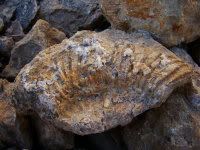 This area was formerly under the sea. The waters covered all of what today is northern Patagonia, which is why you can found ammonite fossils and others in abundance just by looking around your feet in certain places beside the road. When the Andes rose they lifted up the whole area. At present this is over 1,200 meters above sea level (I think La Payunia is even higher). The volcanoes came later. The Payún Liso (the one with the prototypical conical shape in the pictures) is about 3,600 m high.
This area was formerly under the sea. The waters covered all of what today is northern Patagonia, which is why you can found ammonite fossils and others in abundance just by looking around your feet in certain places beside the road. When the Andes rose they lifted up the whole area. At present this is over 1,200 meters above sea level (I think La Payunia is even higher). The volcanoes came later. The Payún Liso (the one with the prototypical conical shape in the pictures) is about 3,600 m high. The soil, as you can see, has several different colours. They correspond to different compositions of lava and ejecta from the volcanoes. None of them is truly inactive, but I gathered the last eruptions took place millennia ago. Today the visitor walks on a mixture of small porous stones and lava ground to dust, plus volcanic bombs (the one in the picture is about the size of a human head).
The soil, as you can see, has several different colours. They correspond to different compositions of lava and ejecta from the volcanoes. None of them is truly inactive, but I gathered the last eruptions took place millennia ago. Today the visitor walks on a mixture of small porous stones and lava ground to dust, plus volcanic bombs (the one in the picture is about the size of a human head).Payunia is a nature reserve, so visitors cannot alter it in any way. You can't leave or take anything from there (I did take a couple of small rocks). The only way to get there is by a suitable vehicle on a very, very bumpy dirt road, which takes three to four hours, and once within the reserve's limits the vehicle must follow the paths already marked by previous visitors; there are no actual roads of any kind. I don't think it rains often.
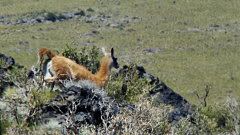 The wind blows all the time with great force — the typical strong Patagonian wind at ground level, and a extremely potent wind when you climb the volcanic hills (our guide took us to a fairly low hill and told us to crawl, not stand up, once we reached the top, since a gust of wind over 100 km/h might easily send a person flying and falling down the volcanic cone). Almost nothing lives here besides a few hardy species of plants, and guanacos, which are protected and, as expected of wild animals, generally don't like people around.
The wind blows all the time with great force — the typical strong Patagonian wind at ground level, and a extremely potent wind when you climb the volcanic hills (our guide took us to a fairly low hill and told us to crawl, not stand up, once we reached the top, since a gust of wind over 100 km/h might easily send a person flying and falling down the volcanic cone). Almost nothing lives here besides a few hardy species of plants, and guanacos, which are protected and, as expected of wild animals, generally don't like people around.Now my advice for photographers is — take good care of your camera. Mine came back full of dust and is still behaving a bit funny; I'd say a reflex with interchangeable lenses is absolutely out of the question, unless you have some magic way to deflect dust, or restrict yourself to one lens for all shots and have it ready in place before you step out the vehicle.
The Payunia package was one of the two things I couldn't do when I went to Malargüe in 2007 (the other was the Valle Hermoso trip, which I'll come to next). It isn't cheap, and it will take you no less than 10 to 12 hours, which is basically your whole day, but if you go to Malargüe, you absolutely must go. You won't get this for less, and you won't get it anywhere else like this. The place is immense, awe-inspiring, and otherwordly — change the colours of the sky, forget the spiny bushes here and there, and you could very well be in Mars. And yet this is truly Earth — in fact it's among the purest manifestations of the forces that made Earth.

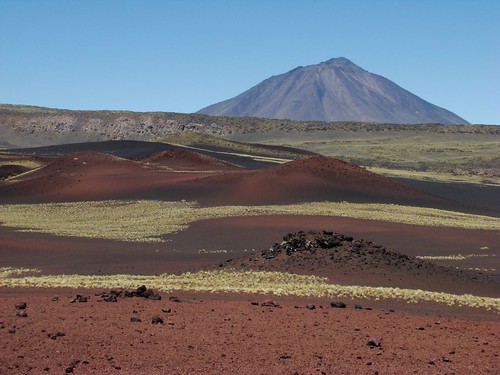
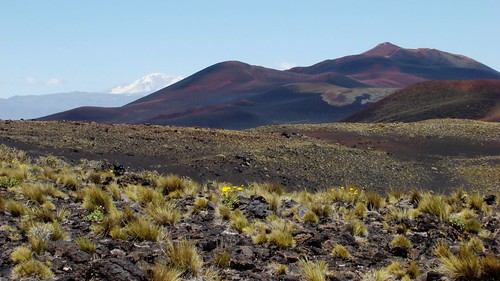
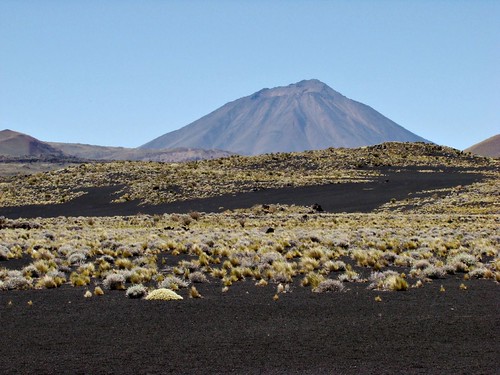













No comments:
Post a Comment
Note: Only a member of this blog may post a comment.